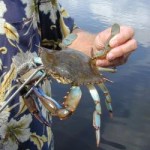Nature’s Balance
By Frank Sargeant, Editor
from The Fishing Wire
It’s a common refrain anywhere anglers want to harvest more of a given species but the regulators won’t let them.’
Biologists say blue crab populations go up and down depending on water quality and habitat conditions, rather than on predatory fish like stripers.“There are too many of these (insert your favorite species) and they’re eating up all the crabs and shrimp-we’ve got to harvest more of them in the name of conservation.”
Yeah we do.
Saltwater anglers in Florida make the charge about Goliath grouper, which they say are eating up all the gags as well as spawning permit-despite the fact that there are now more big gags than there have been in decades and permit are also doing very, very well. Commercial fishermen used to say they had to cut down on redfish numbers or all the blue crabs would soon be consumed. Didn’t happen-today the state is loaded with reds, and crabs numbers come and go, as they always have.
Sharks . . . don’t even get me started.
And presently, Chesapeake Bay commercial fishers are saying that the striped bass are eating up all the blue crabs in soft-shell stage, and that they’d be happy to step in and knock back the numbers of those predatory stripes.
This train of logic has one great failing; it is that somehow, all these species survived in balance before man came along to “help” the predators stay in balance with the prey. The problem, researchers nearly always find, is that habitat issues-sometimes caused by Man but more often by natural variation in temperature, rainfall or other conditions-are depressing the species of concern.
Blues are a delicacy both in their hard-shell form, and as soft-shells eaten whole when moulting.And that seems to be the issue in Chesapeake Bay with the crabs at present. Crabbers there are having a down year, and they say it’s because the striped bass, on a comeback thanks to tight harvest regulations, are eating up all the crabs. They want to see regs relaxed so the stripers can be harvested big, “saving” the crabs-for the crabbers.
But here’s what Brenda Davis, director of Maryland DNR’s blue crab program, says:
“There are no scientific data to support a supposition that striped bass predation is causing a significant depletion of the Chesapeake Bay blue crab population. In fact, studies performed in Maryland and Virginia to assess the diets of striped bass indicated that blue crabs make up a small percentage of the average striped bass diet. According to an intensive study in 2000, fish, particularly menhaden, account for 94 percent by weight of the striped bass diet.
“In fact, other studies have shown that cannibalism by large crabs was a major cause of juvenile crab mortality, accounting for 75 percent to 97 percent of the loss of juvenile crabs in certain locations. Juvenile crabs find protection in grass beds, which is also where striped bass and other predators find the best opportunities for catching them. Nonetheless, crab survival is best in vegetated habitats, where they can hide. Any effort to boost crab survival needs to look toward improving habitat and the protection of sea grass beds.
“There was a combination of environmental factors contributing to the high mortality of juvenile crabs in 2012 including Tropical Storm Sandy, abnormally warm and salty water, decreases in submerged aquatic vegetation coverage, a large influx of red drum into the Maryland portion of the bay, density-dependant mortality, and a large 2011 year class of striped bass.
Striped bass readily eat crabs, but food studies have shown by far the bulk of their diet is baitfish. (Photo Credit Yamaha Marine.)“We don’t have a lot of data on impact of most of the factors on that list. However, we do have solid data that the Bay-wide harvest of spawning age female blue crabs has been at or below the 25.5 percent harvest target for five consecutive years. The ability to keep harvest in the safe range puts us in a much better position than we’ve been in the past (specifically 1992 and 1997) with similar abundance declines,” Davis said.
To be sure, there’s more than a little evidence that terrestrial prey species with a low reproduction rate and slow rates of reaching maturity can definitely be severely impacted by predators-that’s the reason that elk herds are declining in many areas where grey wolves have been reintroduced in recent years.
But for most saltwater fish, crustaceans and shellfish, where the survival strategy is to produce millions of young that grow up fast, biologists have thus far found it pretty much unheard of for a single type of predator to wipe out a prey species.
Bottom line is that if we do our best to maintain a healthy environment for all ocean species-and don’t overharvest any of them ourselves-nature will find a balance that creates a livable abundance for all.


